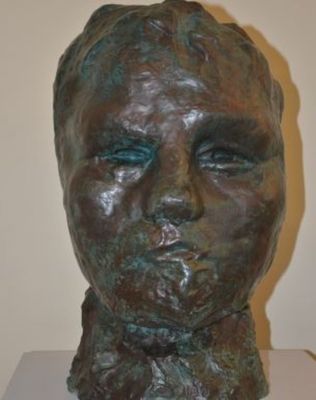
Description
A small number of Rodins sculptures were private in nature and had no place in the public repertoire of sculpture of the time. They were byproducts of his public commissions and were only publicly exhibited after 1900, by which time the sculptor had become so well established as to be immune to criticism. Among such works is MITs Large Head of Iris, modeled in a small terracotta version probably around 1890-91, but not exhibited until 1909. Its genesis and precise date of execution are unknown. It may first have been conceived for The Gates of Hell, perhaps to join the arrangement of agonized heads on the lintel above the figure of The Thinker. If so, Rodin would have modeled it by the end of 1895. Alternatively, it may originally have been conceived for the Monument to Victor Hugo, commissioned in 1889. The various ideas for the Hugo monument included the writer surrounded by three muses or by other allegorical figures. Among the latter, in one unpreserved version of 1890, was a figure of Iris. Rodin may have considered the head too powerful or expressive for any body to support it convincingly. The head was subsequently joined with an independently executed body to the so-called Crouching Woman. This body was probably conceived ca. 1890-91 for the Hugo monument but, like the head, was also eliminated. The head was enlarged without modification from the original terracotta to over twice life-size (23 inches) ca. 1880-91, and was first exhibited in 1909 and 1910. The only recorded bronze of the Large Head of Iris cast during Rodins lifetime was made for a 1914 gift of the Crouching Woman to the Victoria and Albert Museum in London. Another cast, now in the Muse Rodin in Paris, may have been made at that time for Rodin himself. MITs Large Head of Iris was cast in 1968 as number five of an edition of twelve authorized by the Muse Rodin. Other authorized editions in bronze have been cast in the final, large size as well as in two smaller sizes (4 and 7 inches). Rodin frequently named his works after their conception and execution. Such afterthoughts sometimes help us understand how the artist himself interpreted the work. When first exhibited, Rodin entitled the enlarged sculpture Head of Demeter, only subsequently renaming it a head of Iris. Albert Elsen has suggested in an unpublished essay that one might read the twisted and bitter countenance as Demeters response to Hadess abduction of her daughter Persephone. The face could equally well represent Iriss anguish at the lack of individual will in her role as messenger of the Olympian gods. Rodin probably withheld the Large Head of Iris from public view until 1909 because of its rough modeling and lack of conventional surface finish. It was not, however, a sketch that the artist intended to carry to greater completion. Unlike his portrait heads of women in marble and bronze, with their smooth, refined surfaces and flattering idealizations, the Large Head of Iris is loosely and informally modeled. Rodins manipulation of the surface signals the beginning of the release of sculpture from the demands and expectations of verisimilitude. The head is not so much flesh as it is pure sculptural substance and wholly the sculptors invention. It is no longer anatomy but the action of the hand in clay that determines the form. As Albert Elsen has observed, it is Rodins proof that the beauty of art resides in its making. Rodins powerfully modeled surfaces and anatomical distortions enriched the possibilities for psychological and emotional expression. Rodin himself wrote: If the artist only reproduces the superficial features as photography does, if he copies the lineaments of a face exactly, without reference to character, he deserves no admiration. The resemblance which he ought to obtain is that of the soul: that alone matters; it is that which the sculptor or painter should seek beneath the mask of features.
Details
- Work Date:
- 1890-91
- Location:
- Room No. 1
- Dimensions:
- 23.63 in. x 15 in. x 18 in. (60.01 cm x 38.1 cm x 45.72 cm)
- Medium:
- Bronze
- Credit Line:
- Purchased with MIT Percent-for-Art Funds